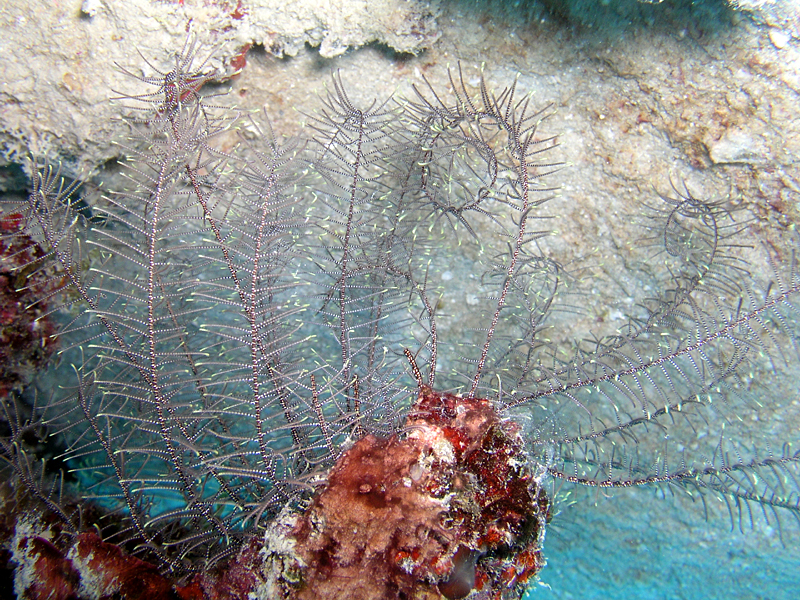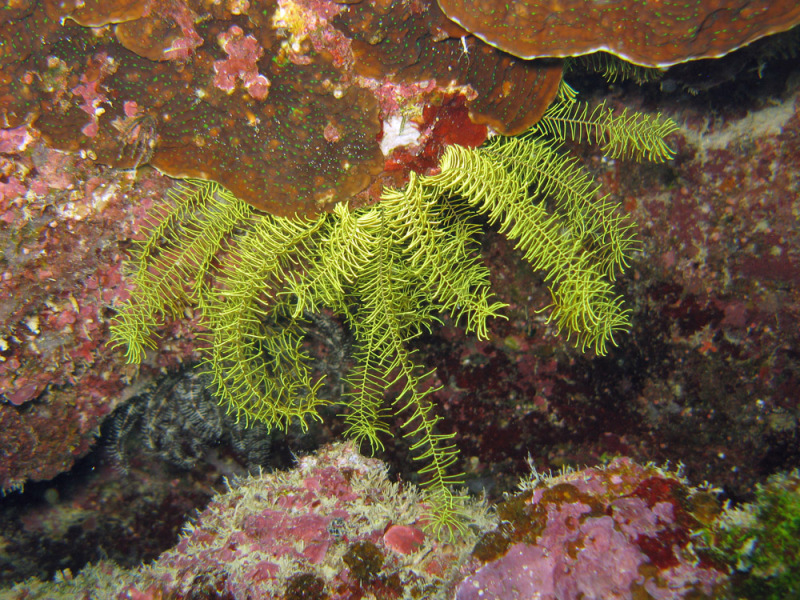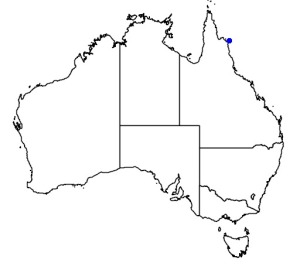
©Lyle Vail: Underside of Phanogenia gracilis showing the distinctive small centrodorsal plate surrounded by large radial plates and no cirri. The brittlestar is Ophiomaza cacaotica. Off Crystal Beach, Lizard Island.

©Lyle Vail and Anne Hoggett: Phanogenia gracilis at Lizard Island. Note the extremely fine arms and pinnules.
Colours
Distinguishing features
Comatulids are distinguised from all other featherstar families by having terminal segments of the oral pinnules modified to form a comb. Comatlids also have a distinctive "feel" due to well developed hooks on most pinnules that cause them to cling like velcro. This species and its congener, Phanogenia multibrachiata, are the most delicate and "clingy" of the comaulids. Even a gentle brush against the arm tips will cause them to cling and break.
Phanogenia gracilis has 60 to 120 very fine arms and no cirri. There are two morphotypes outlined by Messing (1998). These were investigated by Owen et al (2009) who found that there may be three cryptic species involved that do not conform to the morphotypes.
Colour and colour pattern vary widely within this species. It often comprises small, unordered patches of two or three colours but it may be a single solid colour with or without contrasting pinnule tips. Yellow and black is a common colour combination. Another common colour form is solid grey with orange pinnule tips.
Comasterids are distinguised from all other featherstar families by having terminal segments of the oral pinnules modified to form a comb. Comasterids a also have a distinctive "feel" due to well developed hooks on most pinnules that cause them to cling like velcro.
Phanogenia gracilis adults have more than 80 extremely fine arms and no cirri. This species and its congener, P. multibrachiatus, are the most delicate and "clingy" of the comasterids. Even a gentle brush against the arm tips will result in the arm tips breaking and sticking to whatever brushed against them.
Colour and colour pattern vary widely within this species.It often comprises small, unordered patches of two or three colours but it may be a single solid colour with or without contrasting pinnule tips. Yellow and black is a common colour combination. Another common colour form is solid grey with orange pinnule tips.
Size
- Size data has not been obtained.
Depth range
- Depth range data is not yet available.
Synonyms
Similar taxa
-
Animalia:
species: Phanogenia multibrachiata
has a good ring of cirri.
Distribution
Distribution and habitat preferences
Central body concealed within the reef and a bush of arms exposed.
Common around the perimeter of the island group and in the entrance channel to the lagoon. It is found less frequently within the lagoon.
Phanogenia gracilis lives with its central body concealed within the reef and a bush of arms exposed.
Phanogenia gracilis is common around the perimeter of the island group and in the entrance channel to the lagoon. It is found less frequently within the lagoon.
Web resources
References
- Clark, A.M. and F.W.E. Rowe (1971). Monograph of shallow-water Indo-west Pacific echinoderms British Museum (Natural History), London.
- Eeckhaut, I., M.J. Grygier and D. Deheyn (1998). Myzostomes from Papua New Guinea, with related Indo-west Pacific distribution records and description of five new species, Bulletin of Marine Science, 62(3): 841-886. LIRS catalog number 557.
- Grygier, M.J. (1989). Three new species of Myzostoma (Myzostomida), Proceedings of the Biological Society of Washington, 102(3): 793-804. LIRS catalog number 289.
- View all references








